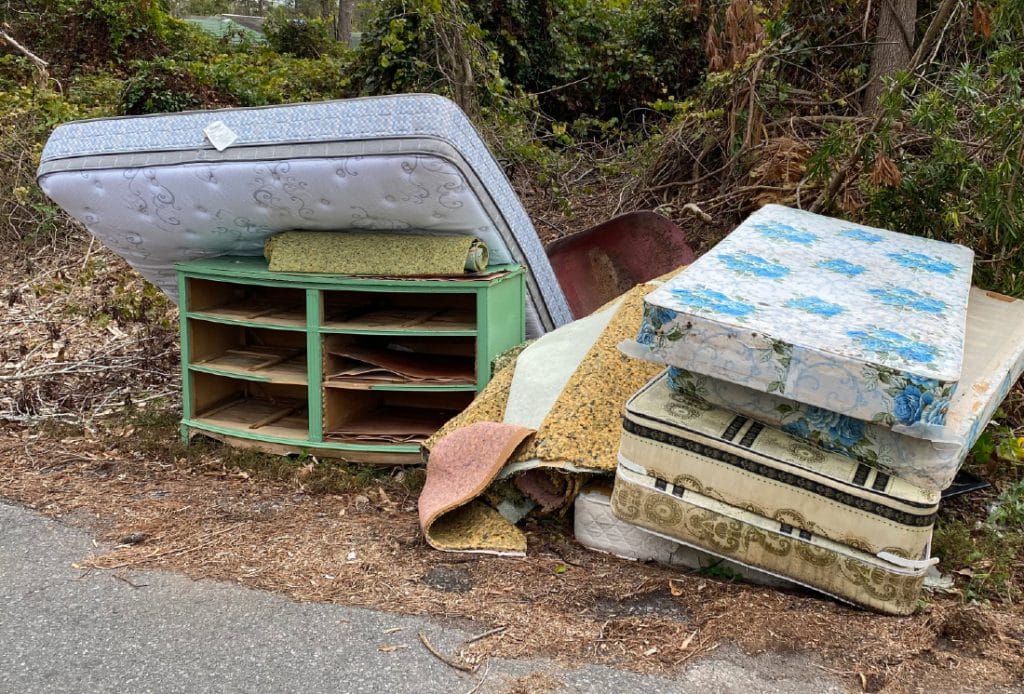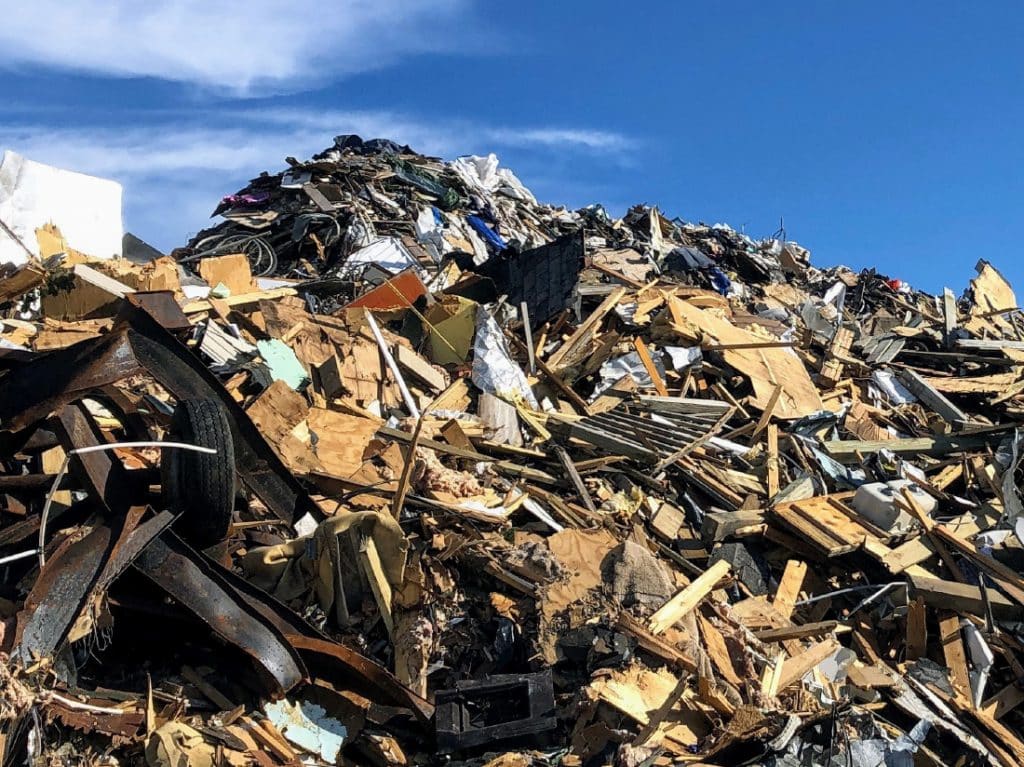What Does Your Storm Debris Say About You?
By Brad Goins
Not long after Laura hit, local government sent out a press release that made it clear that when people put their wreckage from the hurricane out on the curb, vegetation — that is, tree — debris should be kept separated from house debris.
The press release stated pretty strongly that “white goods” were not to be mixed in with the massive tree trunks and sheets of siding that lined the roads.
I know this rule was not followed to the letter. One day, about two months after Laura’s landfall, I sat in my office and watched through a window as someone drove his pickup up on the lawn in front of the house across the street. After the guy parked, he unloaded a full-size couch and a big white dryer, then placed them both on the curb, right next to the city drain.
This fellow obviously had the ability to haul his white goods and furniture to any nearby dump. He must just have preferred to have government contractors do his hauling for him.
One can understand the temptation. Even the day after a hurricane’s landfall, the move is on to haul away debris fast. It’s little surprise if people consider hauling the little piles of trash that have been growing inside the house outside to the curb.
The temptation is not all that powerful when the homeowner knows that the curb is already covered with piles of tree limbs. But anyone who was watching the progress of the piles of roadside debris — and thousands were — knows that as soon as the clusters of tree branches were scooped up and hauled away, they were replaced by clusters of household waste.
You could tell that many folks weren’t concerned about how the sight of all this domestic trash might affect others. Their entire mentality could be expressed in these imperatives: “Get it out to the curb and don’t worry about it.”
Some used the big cleanup as an opportunity to get rid of their paper goods, and in particular boxes in which they’d gotten goods from Walmart and Amazon delivered during the COVID shutdown. As the rains gradually tore these paper products apart, the paper and wood pulp melded with the other trash to form an amalgam that looked like a huge junior high papier maché project gone wrong.
The adversities of hurricane recovery did nothing to alleviate stupid. Conspicuously stupid were the people who bought huge electronic devices, such as televisions and computers, then left the empty boxes right out on the curb where anyone driving by could see them. It was the equivalent of putting up a big sign that read: Hey! I just bought a bunch of expensive new electronics and they’re all just sitting around my house waiting for you to liberate them.
The melting paper may not have looked good. But at least it didn’t reek. It was never going to smell worse than it did on the day it was brought to the curb.
The same cannot be said for the trash of those who used the throw-away period to air their dirty laundry in public. I began to see bedding showing up in the piles of domestic garbage. Pillows and blankets were the main culprits. But a fair number of mattresses also made their way to the curb.
It’s a peculiarity of mine that I don’t want to see anyone else’s bedding. I don’t want to touch or smell it, either. If I’m a pedestrian, I don’t want to walk next to it.
Clothing is just as bad. I saw clothing inside, on top of and all around the garbage piles. Was this clothing used or new? I had no idea. I didn’t see how I could know. I saw a pair of white pants lying in the gutter next to a drain. A single pair of panties lying by itself in the middle of a driveway. How did these things get where they were? Who brought them there? How did it happen?
The same basic situation applies. I don’t want to mess with someone else’s dirty clothing. I have a hard enough time dealing with my own.
It wasn’t as if I felt like going up and knocking on doors and telling people to keep their private stuff inside their homes or inside their trash cans. I will do anything to avoid talking to people I don’t know. But it bothers me a little that I’ve now walked down the middle of a certain road 200 times in order to avoid a pair of white pants lying in a gutter. Still, I admit that this problem may say more about me than it does about the pants.
The disposal of used bedding and clothing is not the worst debris crime. How about the disposal of food? This is where the stink factor really comes into play.
In the early part of the post-Laura period, the City of Lake Charles established special sites where “spoiled goods and household waste” could be dropped off. Everyone understood that foods in refrigerators and freezers were inevitably casualties of hurricane power failures.
But what about people who didn’t get their perishable goods disposed of until some weeks after Laura hit Cameron and Calcasieu? I refer you, in particular, to one large trash can that sat in front of an apartment building. Now, on the positive side, the people in the apartment building were at least trying to put their leftover food in a trash can. On the negative side, some of them weren’t trying very hard. It was as if some tenants couldn’t quite muster the energy to make it to the can, so they just threw the food in the general direction of the can. As a result, the food landed in the gutter, on the dirt or on the side of the garbage can. (Yes, I did see food on the side of the can.)
There is something unsettling about seeing all the components of a meal spread out over a sidewalk. My fear was that the combination of the decaying food and the concentration of flies would dissuade apartment residents from using the can in the future, with the result that they would simply drop their leftover food straight onto the sidewalk.
When the government contractors finally picked up the stinky food, I was surprised by how thorough their work was. It was as if they had scraped the various meals off the sidewalk. I don’t think anyone actually did that. But it was striking how — relatively — clean the area was. Thank the Lord for small favors.
As bad as this ratched food pile was, it was nothing compared to the bad boys of roadside food dumping. I came to think of one especially large mound of waste on the side of a major thoroughfare as the fast food dump. It was made up largely of old fast food sacks and boxes and cups, many of them from restaurants that had not reopened after Laura. I was somewhat tempted when I saw half a roll of Hi-Ho crackers in the middle of the sidewalk. But in the end, I just stepped over the Hi-Hos and kept walking.
It wasn’t so easy when I saw a large, open Styrofoam container on top of the heap one morning. Nestled in the container was a full entree of Italian food. It looked fresh and appetizing. I had to wrestle with my bad thoughts: “Just take it to work. Heat it up a little. I bet it tastes fine. I’m sure it won’t hurt you to eat it.” Days later, the Italian entree is still just sitting there. It looks a little less appetizing with each day that passes. The food is losing its color and becoming uniformly gray.
In many debris piles, the type of debris that was dominant gave the pile its distinctive quality. One pile was built around a mysterious combination of hundreds of toys. It was the closest I’ll ever come to walking though an open-air Toys ‘R Us. The pile changed appearance each day as additional toys were brought out. One day, sitting on top of the pile, there was a three-feet-high plastic trash can decorated with the art of B. Kliban. (Kliban was a Playboy illustrator whose comedic cartoons about cats were extremely popular in the 1970s. His first book, Cat [1975], was followed by Never Eat Anything Bigger Than Your Head [1976] and Whack Your Porcupine [1977].) Not only did the trash can look snazzy, but I figured it might also be worth something. (The current catalog of B. Kliban products at eatmousies.com does not even contain a waste basket.) But I never could motivate myself enough to carry the trash can away. The logistical difficulties of carrying a large trash can always outweighed my momentary desire to become a B. Kliban collector.
When the toy pile was finally hauled off, I once again marveled at the thoroughness of the clean-up. Little bright yellow, red and green toy parts will be popping up through the dirt in this place for years. But only the really careful observer will be able to guess that the land was once the site of a treasure trove of play pretties.
Trash piles revealed various quirks and eccentricities of particular landowners. On one curb was an assembly of huge pieces of gigantic tree trunks. The landowner had adorned each enormous chunk of organic debris with a small white paper sign on which the word LEAVE had been written. The signs worked. A month after the signs were put on the wood, the tree trunks are still just sitting there.
One stretch of sidewalk had the distinction of being covered with a coating of broken glass. Such a thing is not really remarkable after a hurricane. What was remarkable was that the glass fragments were covered by a bigger, thicker layer of shattered glass a few weeks down the line. Had someone decided to used this particular stretch of sidewalk for an obscure private glass breaking ritual?
As we’re going through this survey of local trash, let’s not forget those who erred in the placement of their debris. They could have put their giant tree branches and razor-sharp gutter pieces on their own yards. Instead they draped them across the sidewalk and let them jut out into the street. Did they have no concern about the welfare of their fellow man? Well, it’s not that. They just never thought about their fellow man. Besides, having the sidewalk blocked by a bunch of logs is not a whole lot worse than having it blocked by a dually.
Every day I look the fool as I stand behind a pile of protruding debris, waiting for the oncoming vehicles to pass so that I can step out into the road. I can only hope that the drivers get some entertainment out of the situation.
But, in fact, at this point, things are not that bad anymore. We are no longer obliged to walk down the middle of the street for blocks on end. And we certainly no longer have the ferocious heat to contend with. Things could be a lot worse.
The cleanup process is far from over. However, even though there are still quite a few shingles and broken branches, for the most part, we now have the ability to use or misuse the sides of our streets again. We can now walk the frivolous trash that we know is not a hurricane cleanup priority out to the curb with an easy conscience.
And if we’re concerned that something on our curb reveals information about us that is a tad more personal than we’d like, we can at least take comfort in knowing that it will all be picked up in a day or two.


















Comments are closed.